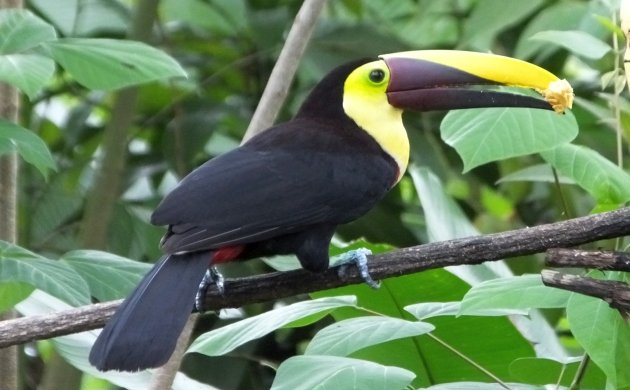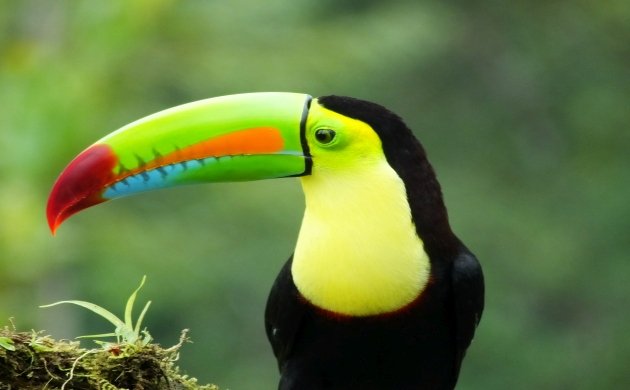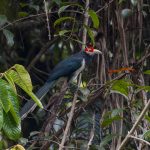
For many folks who live in places with cold winters, toucans are the birds on cereal boxes. While growing up in western New York during the 70s and 80s, sure, we could have found some information, some illustrations of toucans at the local public library. But that would have required a lot more time and tedious effort than gazing at a cereal box accompanied by a sugar-soaked breakfast. It was all too easy to look at that natural cartoon of a bird and leave it as that; some funny looking caricature of a supposed wild bird because really, how could such a strange thing exist?
Hijacked for marketing on account of colorful outrageous plumage and appearance, toucans were relegated to the realm of the cartoon. That one with the cereal looked cool but of course it did because it was just a multi-colored drawing with a happy face. It wasn’t like the Blue Jay that bantered and taunted from the snowy backyard maples as we slurped sugar-sweet milk. While the jays did catch our attention by way of a smart crest and different shades of blue and gray punctuated by a black necklace and mascara, they were part of our common natural experience, their existence was taken for granted. Toucans, though, were something made up and could never have anything in common with a cardinal, jay, or chickadee. The irony is that toucans are actually a lot like jays, so much so that they somewhat fill the niche of Corvids in many Neotropical regions. Like crows and jays, they are social, vocal, intelligent, and omnivorous (including eating eggs and nestlings).
Yes, this bird acts like a jay.
That’s how we knew toucans in the pre-tablet, pre-smart phone days and who could blame us? There were birds to watch but they were the gulls and ducks on the river, the sparrows in the fields, the finches that came to the feeder, the beautiful American Kestrel on the roadside wire. Toucans were something else entirely and we couldn’t even see them at the local zoo. I think this is one of the reasons why so many people visiting Costa Rica want to see the bird with the big banana bill, some ask if you have seen “the toucan”. Photos and field guides have shown them that these fantastic cartoonish birds do indeed exist and they have heard that a lot of visitors to Costa Rica see toucans.
Much to the good fortune of resident and visiting birders in Costa Rica, this is true, we see toucans at many sites in the country. Most are fairly common and given their striking plumages, it’s hard not to notice them. Their curious behavior and devious actions also make it even more of a challenge to take the binos off of these birds. These are the six species that occur in Costa Rica:
Yellow-throated Toucan (Ramphastos swainsonii)

About the same size as a crow, this colorful creature is the largest toucan species in Costa Rica. A bird of lowland and foothill rainforest, the Yellow-throated Toucan can be seen in most parts of the Caribbean slope and from the Carara area south to Panama. Formerly known as the Chestnut-mandibled Toucan and then Black-mandibled Toucan, it is often found in fruiting trees.
As with related species in South America, pairs also give a loud yelping duet from the top of canopy emergents in the morning and late afternoon. They visit feeders on occasion and always seem to be looking for trouble.
Keel-billed Toucan (Ramphastos sulfuratus)

Slightly smaller than the Yellow-throated Toucan, this bird with the rainbow colored beak is a fairly common resident of the eastern and northern part of Costa Rica. It also persists in some parts of the Central Valley where it forages in huge, remnant fig trees. Like the Yellow-throated, it also calls from the tops of tall trees but instead, gives a frog-like croaking call.

This and the Yellow-throated seem to be especially common in the lowland rainforests near the Caribbean coast south of Limon and can be seen moving together in mixed flocks that include woodcreepers, oropendolas, and other medium to large birds.
Collared Aracari (Pteroglossus torquatus)

Small, lanky, very social toucans with serrated beaks, these birds will eat anything they can catch. When aracaris go after young birds and other small animals, I can’t help but think of miniature velociraptors.

These colorful, exotic birds are often seen moving through forest and second growth in groups of 8 or so individuals in search of fruit, nests, and small creatures. In Costa Rica, this species lives in the lowlands and foothills of the Caribbean slope and in parts of the Nicoya Peninsula.
Fiery-billed Aracari (Pteroglossus frantzii)

The counterpart of the Collared Aracari on the South Pacific slope of Costa Rica, this near endemic also ranges into parts of western Panama. It also occurs in some parts of the Central Valley and carries out the same devious operations as the Collared Aracari.

Yellow-eared Toucanet (Selenidera spectabilis)

This small, striking toucan is the least social of the bunch and much more difficult to see. It doesn’t seem to be as common and likely requires large areas of mature foothill and middle elevation rainforest on the Caribbean slope.

Female Yellow-eared Toucanet. This is one of the few toucan species where the sexes have different plumages.
Pairs are usually seen at fruiting trees and on a jackpot day of birding, can be seen foraging in the same area as the two large toucans and Northern Emerald Toucanet. One of the best areas for this species in Costa Rica seems to be the Arenal region.
Northern Emerald Toucanet (Aulacorhynchus prasinus)

Small, beautiful, common and regular at feeders, these attributes don’t make this little toucan any less voracious. One of the main predators of quetzal nests, the Northern Emerald Toucanet is a signature species of middle and high elevation forests in Costa Rica.

It’s repetitive barking call is often heard and it is usually found at fruiting trees. This species also tends to forage in pairs or small family groups.
Want to see toucans in Costa Rica? Go birding in just about any area with forest, they are hard to miss!













Thank you for this summary and gorgeous photos!
Much like you described, my fasination with these wonderful birds was borne of the ceral box! So you can imagine my joy, when seeing my first one, a Keel-billed Toucan near Sarapiqui. Great story and marvelous pictures!